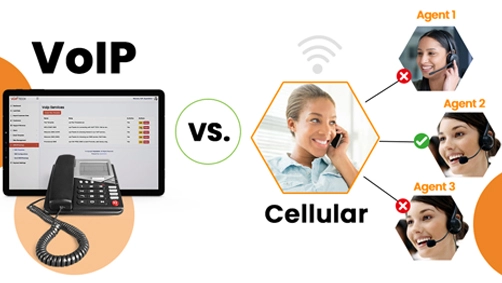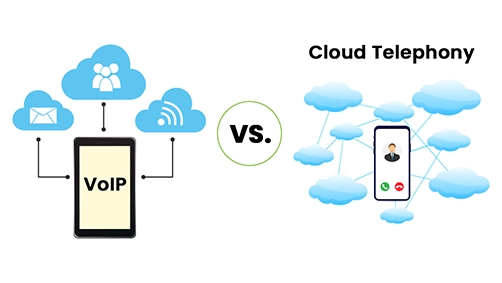VoIP (Voice over Internet Protocol) is a digital communication system that transmits voice using IP (Internet Protocol) networks through packet-switching. It offers businesses a flexible, mobile, and cost-effective alternative to legacy phone systems.
This article compares VoIP with other major technologies: PSTN (Public Switched Telephone Network), ISDN (Integrated Services Digital Network), cloud telephony, and cellular networks. Key factors include cost-efficiency, scalability, mobility, hardware requirements, call quality, infrastructure, failover readiness, and compliance.
VoIP uses SIP (Session Initiation Protocol) to enable voice, video, and messaging services. In comparison, PSTN and ISDN run on circuit-switched infrastructure, cellular networks rely on radio access technologies, and cloud telephony delivers a hosted VoIP experience with managed services.
The sections ahead explore each system’s strengths, limitations, and best-fit use cases. The content addresses hybrid deployments, compliance constraints, migration approaches, and VoIP's potential to replace traditional business telephony.
What is VoIP and how does it differ from traditional communication systems?
VoIP works by converting voice into small data packets and sending them over the internet. This makes calling faster, cheaper, and more flexible.
Older systems like the PSTN (Public Switched Telephone Network) and ISDN (Integrated Services Digital Network) use circuit switching. These systems need a dedicated line for each call.
VoIP uses packet switching, allowing voice data to move through shared digital routes. This improves efficiency and lowers infrastructure costs.
A key protocol used in VoIP is the SIP (Session Initiation Protocol). It handles signaling, manages call setup and teardown, and supports voice, video, and messaging. SIP is widely adopted due to its simplicity, scalability, and system interoperability.
VoIP vs PSTN

PSTN uses fixed lines and circuit switching. It's stable, but aging and expensive to maintain. In contrast, VoIP operates over internet-based networks. It's more flexible and modern, using data packets instead of dedicated physical lines.
Cost
PSTN calls, especially international ones, are expensive due to long-distance infrastructure. VoIP calls are far cheaper, often close to free.
Scalability
Adding new PSTN lines takes time and hardware. VoIP can scale quickly with just software and internet access.
Hardware
PSTN needs physical phones, wires, and switches. VoIP works with smartphones, laptops, or IP phones. No bulky hardware is required.
Call Quality
PSTN offers consistent quality, but lacks upgrades. VoIP can deliver HD audio, but depends on internet strength and stability.
Power & Redundancy
PSTN works during power outages due to its own power supply. VoIP needs battery backup or cloud failover plans to stay online.
Pros and Cons at a Glance
|
Feature |
PSTN (Public Switched Telephone Network) |
VoIP (Voice over Internet Protocol) |
|---|---|---|
|
Pros |
- Works during power cuts |
- Lower call costs |
|
Cons |
- Costly setup and calls |
- Needs strong internet |
VoIP vs Cellular Networks

VoIP is best for office setups, remote teams, and customer service centers. It works well where good internet is available.
Cellular networks like GSM, 4G, and 5G are ideal for on-the-go communication. They’re built for outdoor coverage and mobility.
Reliability
Cellular networks offer steady coverage in most outdoor areas. VoIP depends on stable internet and may drop on weak connections.
Call Handoff
Cellular supports smooth call handoff between towers while moving. VoIP can struggle with handoff if internet drops or shifts.
Flexibility
VoIP works through apps on phones, desktops, or browsers. It lets users take calls from anywhere with internet access. However Cellular needs a SIM card and phone. It’s less flexible but doesn’t rely on Wi-Fi or broadband.
Cost
VoIP usually has lower monthly costs and no per-minute charges. Cellular plans often include call limits and higher mobile data rates.
Network Dependency
VoIP relies fully on internet strength. Without good bandwidth, calls can break or lag. Cellular handles calls even in rural zones.
Quality of Service (QoS)
VoIP may face jitter, latency, or packet loss, especially on busy networks. Cellular calls are more stable, though not always crystal clear.
VoIP vs Cloud Telephony

Cloud telephony is a hosted version of VoIP. It runs entirely on third-party cloud infrastructure.
With VoIP, businesses can build and manage their own phone system. This gives more control but requires setup, maintenance, and security.
Cloud telephony shifts all of that to a provider. They handle servers, updates, backups, and scaling on your behalf.
Infrastructure Management
Self-hosted VoIP needs in-house servers or cloud deployment you control. Cloud telephony is plug-and-play with zero hardware to maintain.
Vendor Support
VoIP setups may need internal IT or outsourced experts. Cloud telephony includes support, onboarding, and regular monitoring as part of the plan.
Licensing and Pricing
VoIP systems often have one-time costs and open-source options. Cloud telephony follows a subscription model with monthly or per-user pricing.
Which Should You Choose?
Go with self-hosted VoIP if you want full control, have IT resources, and can manage updates and security. Choose cloud telephony if you prefer ease, speed, and built-in support. It’s ideal for teams without technical staff.
VoIP vs Analog Landlines

Analog landlines use physical copper lines and traditional desk phones. They work well for basic calling but lack modern features.
VoIP is digital and cloud-based. It supports software phones, mobile apps, and advanced call routing from any location.
Here’s how they compare:
Equipment
- Analog: Requires physical desk phones, wiring, and a landline connection
- VoIP: Works with IP phones, headsets, softphones, or any device with internet
Expandability
- Analog: Adding lines needs rewiring and physical ports
- VoIP: Add or remove users instantly through software
Remote Access
- Analog: Calls can only be answered from one fixed location
- VoIP: Access calls from anywhere using apps, browsers, or cloud tools
Features
- Analog: Limited to voice calls and basic voicemail
- VoIP: Supports call routing, voicemail-to-email, video, and analytics
Can VoIP coexist with other communication systems in hybrid environments?
Yes. VoIP can work alongside older systems in hybrid communication setups. Many businesses do this during transition phases. A typical hybrid model uses VoIP for internal calls and desk phones. Mobile networks serve as a backup when staff are remote or traveling. The PSTN provides a failover option during internet issues.
These mixed setups help businesses stay connected in all conditions. They also reduce downtime and ensure continuity during system upgrades.
In some organizations, full VoIP replacement is not possible right away. Legacy phone systems may still support hardware, remote branches, or specialized equipment.
A phased rollout helps in such cases. It allows teams to switch in steps, starting with one department or office. Over time, VoIP adoption grows as confidence builds.
Gradual migration reduces risk and keeps communication steady. It also gives employees time to learn the new tools without pressure.
Hybrid setups bring flexibility, reliability, and control. They help businesses modernize without risking disruption.
What factors should businesses evaluate when choosing between VoIP and other technologies?
Choosing the right communication system depends on how your business operates, grows, and serves customers. VoIP works well for many, but it’s not always the best fit for every setup.
Here’s a checklist to help decision-makers compare VoIP with other technologies:
Business Size and Team Structure
- Small teams may benefit from simple VoIP apps or cloud telephony
- Large businesses might need advanced features, integrations, and multiple lines
Call Volume and Type
- High-volume centers need scalable, reliable systems with call routing and analytics
- Occasional calling needs can work with simpler, mobile-based setups
Remote Access and Mobility
- VoIP is ideal for teams working from different locations or home offices
- Traditional setups may limit mobility and remote productivity
Support and Maintenance
- Consider your in-house IT team’s ability to manage the system
- VoIP may require ongoing monitoring, updates, and security support
Infrastructure and Technical Readiness
- Check your internet bandwidth, network stability, and hardware
- VoIP depends on strong, stable connections for call quality
Budget and Cost Structure
- VoIP often has lower upfront costs and flexible plans
- Traditional systems may require large setup fees and long-term contracts
Backup and Continuity
- Ensure backup options for power or internet failures
- PSTN fallback, mobile routing, or cloud redundancy can keep calls running
Evaluating these areas helps you match the right solution to your actual business needs — now and as you grow.
Comparison Table: VoIP vs PSTN vs Cellular vs Cloud Telephony vs ISDN
|
Feature |
VoIP |
PSTN |
Cellular |
Cloud Telephony |
ISDN |
|---|---|---|---|---|---|
|
Cost |
Low setup and call cost |
High setup and call cost |
Moderate to high, depends on plan |
Subscription-based, cost-effective at scale |
High installation and usage costs |
|
Maintenance |
Requires IT support or service provider |
Low maintenance but outdated infrastructure |
Minimal maintenance required |
Provider handles all maintenance |
Costly due to legacy equipment |
|
Mobility |
High – works anywhere with internet |
Very low – fixed location |
Very high – ideal for on-the-go use |
High – mobile app access and browser-based |
Low – tied to physical lines |
|
Security |
Depends on network setup and encryption |
Generally secure, but lacks modern safeguards |
Carrier-managed security, limited user control |
Secured by provider, depends on vendor setup |
Outdated security standards |
|
Scalability |
Easily scalable with software configuration |
Hard to scale – needs physical wiring |
Scales by adding SIMs and devices |
Highly scalable with minimal effort |
Limited scalability due to legacy design |
|
Support Model |
Self-managed or outsourced |
Carrier or internal telecom support |
Carrier-based support |
Fully managed by provider |
Legacy telecom support, limited expertise |
|
Redundancy & Failover |
Needs planning (cloud backup, mobile failover) |
Built-in fallback during power cuts |
Tower switching and backup networks |
Built-in redundancy through cloud systems |
Limited failover options, often single-path |
|
QoS Sensitivity |
High – sensitive to jitter and latency |
Low – consistent quality |
Medium – affected by signal strength |
Medium – managed at provider level |
Low – consistent but aging quality |
What else should decision-makers know about VoIP alternatives?
Choosing between VoIP and legacy systems isn’t always straightforward. Each business has unique needs, budgets, and technical limitations.
Some may worry about internet reliability, migration complexity, or how fast teams can adapt. Others might need a mix of systems during transition.
The next section answers common questions to help you plan smartly, avoid disruption, and move forward with confidence.
Can VoIP fully replace traditional business phone systems?
In most cases, yes. VoIP offers nearly all the same features as traditional phone systems and often more. It supports voice calls, call routing, extensions, voicemail, conferencing, and number management. These match what circuit-based systems offer.
VoIP also scales faster. You can add or remove users through software without rewiring or hardware changes. Support is flexible. Businesses can manage VoIP in-house or rely on service providers for updates and maintenance.
But there are trade-offs. VoIP depends on stable internet. Traditional systems rely on physical circuits, which may be more stable during outages. To bridge that gap, fallback routing is recommended. Calls can switch to mobile networks or PSTN if the internet goes down.
With good planning and backup, VoIP can fully replace older systems for most businesses.
Is VoIP suitable for industries with strict compliance requirements?
Yes, but it depends on the provider and system setup. VoIP can meet standards like HIPAA (Health Insurance Portability and Accountability Act), GDPR (General Data Protection Regulation), and PCI-DSS (Payment Card Industry Data Security Standard). But not all services are compliant by default.
To ensure compliance, businesses must choose providers that offer strong encryption, secure data handling, and relevant certifications. Some VoIP platforms include built-in security features like call encryption, access controls, and secure storage.
Compliance also depends on how the system is configured and maintained. Regular audits and updated policies are key. VoIP is suitable for high-compliance industries like healthcare, finance and legal as long as it's planned and monitored properly.
What are the hidden costs in migrating to VoIP from older technologies?
VoIP often lowers long-term costs, but migration isn’t always expense-free. Some businesses need new IP phones, routers, or headsets to replace outdated hardware. Others may upgrade their internet connection to ensure better call quality. Training is another factor. Staff need time and guidance to adjust to new tools, apps, and call management features. Support contracts may also shift.
You might need a managed service provider or in-house support team to monitor and maintain the system. VoIP relies on internet performance. You may need to invest in QoS (Quality of Service) setup, such as bandwidth upgrades or router configuration. To avoid surprises, plan for the full cost of ownership. Include hardware, setup, training, support, and network readiness in your VoIP budget.







